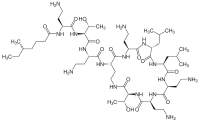
Photo from wikipedia
ABSTRACT Pulmonary administration of polymyxins is increasingly used for the treatment of respiratory tract infections caused by multidrug-resistant Gram-negative bacteria, such as those in patients with cystic fibrosis. However, there… Click to show full abstract
ABSTRACT Pulmonary administration of polymyxins is increasingly used for the treatment of respiratory tract infections caused by multidrug-resistant Gram-negative bacteria, such as those in patients with cystic fibrosis. However, there is a lack of pharmacokinetics (PK), pharmacodynamics (PD), and toxicity data of aerosolized polymyxin B to inform rational dosage selection. The PK and PD of polymyxin B following pulmonary and intravenous dosing were examined in neutropenic infected mice, and the data were analyzed by a population PK model. Dose fractionation study was performed for total daily doses between 2.06 and 24.8 mg base/kg of weight against Pseudomonas aeruginosa ATCC 27853, PAO1, and FADDI-PA022 (MIC of 1 mg/liter for all three strains). Histopathological examination of the lung was undertaken at 24 h posttreatment in both healthy and neutropenic infected mice. A two-compartment PK model was required for both epithelial lining fluid (ELF) and plasma drug exposure. The model consisted of central and peripheral compartments and was described by bidirectional first-order distribution clearance. The ratio of the area under the curve to the MIC (AUC/MIC) was the most predictive PK/PD index to describe the antimicrobial efficacy of aerosolized polymyxin B in treating lung infections in mice (R2 of 0.70 to 0.88 for ELF and 0.70 to 0.87 for plasma). The AUC/MIC targets associated with bacteriostasis against the three P. aeruginosa strains were 1,326 to 1,506 in ELF and 3.14 to 4.03 in plasma. Histopathological results showed that polymyxin B aerosols significantly reduced lung inflammation and preserved lung epithelial integrity. This study highlights the advantageous PK/PD characteristics of pulmonary delivery of polymyxin B over intravenous administration in achieving high drug exposure in ELF.
Journal Title: Antimicrobial Agents and Chemotherapy
Year Published: 2017
Link to full text (if available)
Share on Social Media: Sign Up to like & get
recommendations!